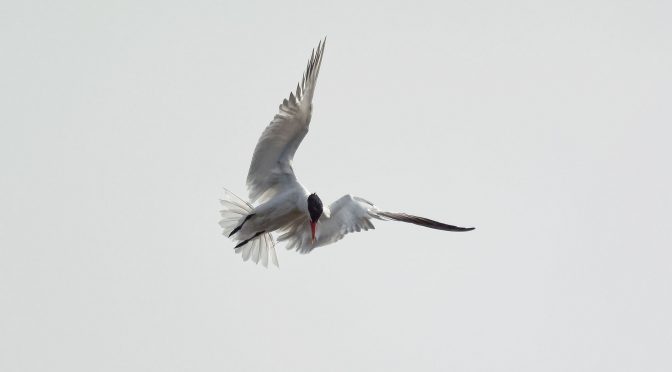Bird photography can become somewhat of an addictive pastime for a number of reasons. One never knows what photographic opportunity Mother Nature will provide, and once presented, if we will be up to the task of capturing it. Many of us regularly go out to photograph birds even though we may already have thousands of images of a particular species. What keeps us coming back is the anticipation that our next image may capture something special, different, or better, than during our last outing. This short article shares some images that (hopefully) demonstrate that wing positions can add drama to our bird photographs.
NOTE: Click on images to enlarge.

Sometimes an image happens in an instant and all we have time to do is wheel around with our camera and grab a quick photograph. Such was the case with the Great Blue Heron image above. I saw this bird swooping in from the corner of my eye and was able to grab a single frame after it landed and ran along the shoreline. I love the position of the bird’s outstretched wings and the splashes it is making with its feet. A bird doesn’t have to be in flight to provide dramatic wing positions.
The next three photographs were from the same 40 image run shot at 60 frames per second just as a tern began to hover.



This hovering behaviour can yield a number of usable photographs from the same image run, often with subtle differences in wing positions. The key with this type of photograph is to consistently track terns in flight waiting for this behaviour to be exhibited as shutter release timing is critical. Sometimes the effort is in vain, and at other times there is a reward for a photographer’s patience.

The hummingbird image above was captured in my backyard during some late day sun. As you can see from the EXIF data, I was pushing my Nikon 1 V3’s capabilities shooting at ISO-6400. I caught the hummingbird as it momentarily backed away from one of the feeders in my yard. The body posture of the hummingbird with its tail up and wings thrust forward while angled towards me is a perspective that I have not captured before.

A split second later the hummingbird moved back towards the feeder, yielding the image above.

I love to capture birds in flight when they are in a banking movement as it reveals more of the underside of their more distant wing as shown with the Great Blue Heron image above.

Sometimes this banking perspective can help make a bird in flight look majestic, like the egret above.

Birds in flight can sometimes treat us to strange, contorted looking wing positions like the tern doing a mid-air shake in the photograph above.

Sometimes resisting the temptation to photograph a bird in flight and waiting until it is coming in to land can also yield some quite dramatic wing positions as seen in the image above.
It is still a thrill to capture photographs of birds in flight whenever I can. I must admit that I am becoming increasingly focused on the nuances of the wing positions of birds and the drama they can add to photographs.
Technical Note:
All photographs were captured hand-held in available light using Nikon 1 gear as per the EXIF data. All images were produced from RAW files using my standard process of DxO PhotoLab, CS6 and the Nik Collection.
Word of mouth is the best form of advertising. If you like our website please let your friends and associates know about our work. Linking to this site or to specific articles is allowed with proper acknowledgement. Reproducing articles or any of the images contained in them on another website is a Copyright infringement.
My intent is to keep this photography blog advertising free. If you enjoyed this article and/or my website and would like to support my work you can purchase an eBook, or make a modest $10 donation through PayPal, both are most appreciated. You can use the Donate button below. Larger donations can be made to tom@tomstirr.com through PayPal.
Article and all images are Copyright 2018 Thomas Stirr. All rights reserved. No use, duplication or adaptation of any kind is allowed without written consent. If you see this article reproduced anywhere else it is an unauthorized and illegal use. Posting comments on offending web sites and calling out individuals who steal intellectual property is always appreciated!


Thomas,
Once again I’m inspired by you to grab my V3 and go out to the Hummingbird feeder.
But 6400 ISO without a lot of noise?
Thanks
Chuck
Hi Chuck,
I hope you have a lot of fun by your Hummingbird feeder with your V3!
I can thank the PRIME noise reduction function in DxO PhotoLab for dealing with the noise in the hummingbird image shot at ISO-6400. As I’ve noted in a number of articles, it is also important to remember that there can be differences between manufacturer stated ISO (i.e. the setting on a camera) and measured ISO (i.e. the ISO at which a camera is actually shooting as determined by lab tests). In terms of the ISO performance of the Nikon 1 V3, at a manufacturer stated ISO-6400 the Nikon 1 V3 is shooting at a measured ISO of ISO-3576 according to DxO.
Tom